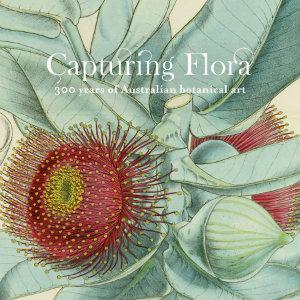This superb book accompanies a major exhibition of the same name at the Art Gallery of Ballarat, the largest of its kind ever undertaken, surveying 300 years of Australian botanical art. Capturing Flora: 300 years of Australian botanical art, the exhibition, run until 2 December.
In its strict meaning, ‘Botanical Art’ is art in the service of science, a form of art making that takes accuracy, exacting mimesis and considered information content as its rationale. An art whose form is dictated by its function. Yet since its earliest days (and the tradition of botanical illustration can be traced through existing manuscripts and early medicinal text books such as Dioscorides’ De Materia Medica to the 3rd century AD in the west, and into antiquity in the east), the aesthetic refinement and appeal to connoisseurs and collectors has been remarkable. There is something extraordinarily and irresistibly seductive about art that is so incredibly difficult and demanding in its exactitude. In an age where photography and digital imaging methods are highly refined, there remains an ability of the very best botanical artists to show and reveal what the camera cannot document in a way that remains truly remarkable.
This book, which is excellent in every dimension, traces the long and surprisingly rich history of botanical art in Australia. The book runs to some 280 pages and comprises six richly illustrated essays; Gordon Morrison on naming and sorting, Jennifer Jones-O’Neill on early encounters, Richard Aitken on the global cultivation of Australian plants, Thomas A Darragh on Colonial Prints; Julie Collett on early female amateurs and Gordon Morrison on decline and rebirth. What makes the publication so attractive, apart from it luxurious visual appeal, is that botanical art reveals an extraordinary amount about history and society – it is much, much more than highly skilled pictures of pretty things.
But 300 years of botanical art for a country claimed by James Cook only in 1776? We learn that in fact Cook himself knew of the botanical illustrations of Australian plants collected by William Dampier’s voyage to New Holland in 1699 (first published 1703). Plants were a mania and an object of status in the Enlightenment. It is no accident at all that Sir Joseph Banks, who travelled to Australia as a young man on Cook’s Endeavour, is known to have spent an astronomical sum (around £100,000, equivalent to millions in modern currency), to produce his Florilegium – his scientific contributions ended up elevating him to the Presidency of the immensely prestigious Royal Society.
We learn that the very system of binomial classification used in the taxonomy of species invented by the Swede Carl Linnaeus, was originally based on using the fine structure sex-organs/flowers of plants as its classification method (which is why plants are so often depicted in partial dissection). Linneaus enjoyed phenomenal fame in his day and aristocratic circles gravitated to his ideas. Part of this attraction was not just to be at the very forefront of the newest ideas; it was to own what no one else owned. The book reproduces a small set of works by Redouté who painted flowers for the empress Josephine, a plant lover extraordinaire whose taste for roses did not prevent her from cultivating extremely rare Australian plants in her expansive gardens at Malmaisson. They were a sensation.
Artists will find this volume of interest not only as a rich source book but also because it goes into considerable detail describing the methods used in making different types of illustration, from the original water colour palettes that may have been used by Ferdinand Bauer, through meticulously exacting steel plate engraving to advanced colour lithography.
In the Victorian era, flower painting became associated with a genteel and feminine pastime, and the forms of botanical art declined after the two world wars. Yet in the last decades there has been a tremendous upswing in interest. Its most able contemporary practitioners not only produce works again coveted by private and public collectors (and commanding quite extraordinary prices), they also continue to extend the form and find ever more beautiful ways to depict plants. Works of the very best of these artists are shown, including Margaret Stones, Betty Conabere, the incomparable Celia Rosser, Anita Barley, Lauren Black’s mosses and Elizabeth Cooper’s and Andrew Seward’s graphite/pencil drawings. Artist David Hockney has always derided the ‘dead-eye of the camera’ – the exceptional history of Australian botanical art shows that when great artists lavish time, effort and skill on a subject they can produce a way of seeing unequalled by any other approach.
Buy this book for yourself, for someone who loves plants, and for someone you want to impress with your own discerningly good taste. A publishing gem and just in time for the holiday season. Highly recommended
5 stars out of 5
Capturing Flora: 300 years of Australian botanical art
Richard Aitken et al.
Hardcover, 280 pages, RRP $65
Capturing Flora: 300 years of Australian botanical art
Art Gallery of Ballarat
25 September – 2 December





